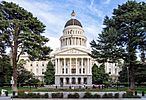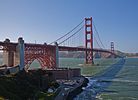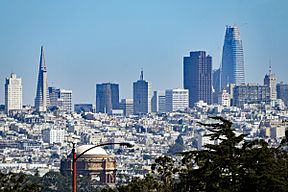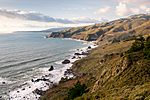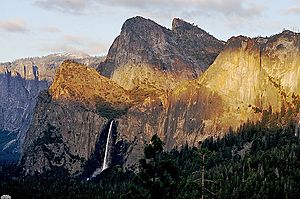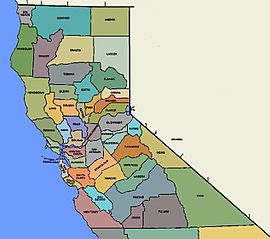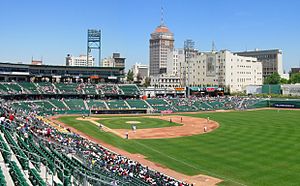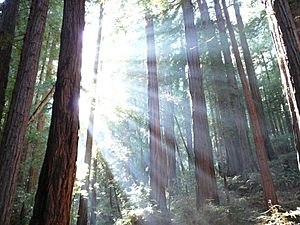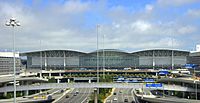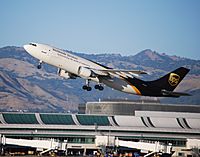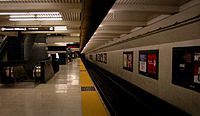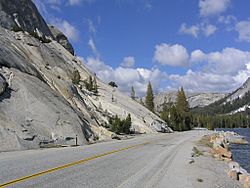Northern California facts for kids
Quick facts for kids
Northern California
|
|
|---|---|
|
From left to right: California State Capitol in Sacramento, Golden Gate Bridge, San Francisco skyline, San Jose skyline, Muir Woods National Monument, the northern California coast as seen from Muir Beach Overlook, view of a gondola in Lake Tahoe, and Natural Bridges State Beach in Santa Cruz.
|
|
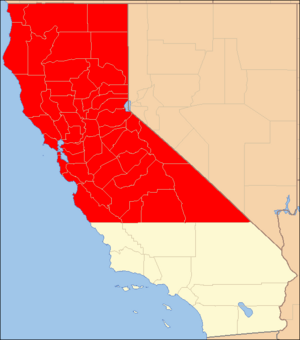
Northern California counties in red
|
|
| Country | United States |
| State | California |
| Major cities | San Jose San Francisco Fresno Sacramento Oakland Stockton Fremont Modesto Santa Rosa Salinas Hayward Sunnyvale Visalia Chico Redding San Mateo San Rafael Eureka Susanville |
| Largest city | San Jose |
| Population
(2015)
|
15,376,997 |
Northern California (colloquially known as NorCal) is a geographic and cultural region that generally comprises the northern portion of the U.S. state of California. Spanning the state's northernmost 48 counties, its main population centers include the San Francisco Bay Area (anchored by the cities of San Jose, San Francisco, and Oakland), the Greater Sacramento area (anchored by the state capital Sacramento), the Redding, California area south of the Cascade Range, and the Metropolitan Fresno area (anchored by the city of Fresno). Northern California also contains redwood forests, along with most of the Sierra Nevada, including Yosemite Valley and part of Lake Tahoe, Mount Shasta (the second-highest peak in the Cascade Range after Mount Rainier in Washington), and most of the Central Valley, one of the world's most productive agricultural regions.
The 48-county definition is not used for the Northern California Megaregion, one of the 11 megaregions of the United States. The megaregion's area is instead defined from Metropolitan Fresno north to Greater Sacramento, and from the Bay Area east across Nevada state line to encompass the entire Lake Tahoe-Reno area.
Evidence of Native American habitation in the area dates from at least 19,000 years ago and successive waves of arrivals led to one of the most densely populated areas of pre-Columbian North America. The arrival of European explorers from the early 16th to the mid-18th centuries did not establish European settlements in northern California. In 1770, the Spanish mission at Monterey was the first European settlement in the area, followed by other missions along the coast—eventually extending as far north as Sonoma County. Over time, droughts and wildfires have increased in frequency and become less seasonal and more year-round, further straining the region's water security.
Contents
Description
Northern California is not a formal geographic designation. California's north-south midway division is around 37° latitude, near the level of San Francisco. Popularly, though, "Northern California" usually refers to the state's northernmost 48 counties. This definition coincides with the county lines at 35° 47′ 28″ north latitude, which form the southern borders of Monterey, Kings, Tulare and Inyo counties. The term is also applied to the area north of Point Conception and the Tehachapi Mountains.
Because of California's large size and diverse geography, the state can be subdivided in other ways as well. For example, the Central Valley is a distinct region in itself both culturally and topographically from coastal California, though in northern versus southern California divisions, the Sacramento Valley and most of the San Joaquin Valley are usually placed in northern California.
The state is often considered as having an additional division north of the urban areas of the San Francisco Bay Area and Sacramento metropolitan areas. Extreme northern residents have felt under-represented in state government and in 1941 attempted to form a new state with southwestern Oregon to be called Jefferson, or more recently to introduce legislation to split California into two or three states. The coastal area north of the Bay Area is referred to as the North Coast while the interior region north of Sacramento is referred by locals as the Northstate.
Significance
Since the events of the California Gold Rush, Northern California has been a leader on the world's economic, scientific, and cultural stages. From the development of gold mining techniques and logging practices in the 19th century that were later adopted around the world, to the development of world-famous and online business models (such as Apple, Hewlett-Packard, Google, Yahoo!, and eBay), northern California has been at the forefront of new ways of doing business. In science, advances range from being the first to isolate and name fourteen transuranic chemical elements, to breakthroughs in microchip technology. Cultural contributions include the works of Ansel Adams, George Lucas, and Clint Eastwood, as well as beatniks, the Summer of Love, winemaking, the cradle of the international environmental movement, and the open, casual workplace first popularized in the Silicon Valley dot-com boom and now widely in use around the world. Other examples of innovation across diverse fields range from Genentech (development and commercialization of genetic engineering) to CrossFit as a pioneer in extreme human fitness and training. It is also Home to one of the largest Air Force Bases on the West Coast, and the largest of California, Travis Air Force Base.
Cities

Northern California's largest metropolitan area is the San Francisco Bay Area which includes the cities of San Francisco, San Jose, Oakland, and their many suburbs. In recent years the Bay Area has drawn more commuters from as far as Central Valley cities such as Sacramento, Stockton, Fresno, Turlock and Modesto. With expanding development in all these areas, the San Francisco Bay Area, Monterey Bay Area, and central part of the Central Valley and Sierra Nevada foothills may now be viewed as part of a single megalopolis. The 2010 U.S. Census showed that the Bay Area grew at a faster rate than the Greater Los Angeles Area while Greater Sacramento had the largest growth rate of any metropolitan area in California.
The state's larger inland cities are considered part of Northern California in cases when the state is divided into two parts. Important cities in the region not in major metropolitan areas include Eureka on the far North Coast, Redding, at the northern end of the Central Valley, Chico, and Yuba City in the mid-north of the Valley, as well as Fresno and Visalia on the southern end. Though smaller in every case except for Fresno than the larger cities of the vast region, these smaller regional centers are often of historical, and perhaps inflated economic importance for their respective size, due to their locations, which are primarily rural or otherwise isolated.
History
Historical events to 1847
Inhabited for millennia by Native Americans, from the Shasta tribe in the north, to the Miwoks in the central coast and Sierra Nevada, to the Yokuts of the southern Central Valley, northern California was among the most densely populated areas of pre-Columbian North America.
European explorers
The first European to explore the coast was Juan Rodríguez Cabrillo, sailing for the Spanish Crown; in 1542, Cabrillo's expedition sailed perhaps as far north as the Rogue River in today's Oregon. Beginning in 1565, the Spanish Manila galleons crossed the Pacific Ocean from Mexico to the Spanish Philippines, with silver and gemstones from Mexico. The Manila galleons returned across the northern Pacific, and reached North America usually off the coast of northern California, and then continued south with their Asian trade goods to Mexico.
In 1579, northern California was visited by the English explorer Sir Francis Drake who landed north of today's San Francisco and claimed the area for England. In 1602, the Spaniard Sebastián Vizcaíno explored California's coast as far north as Monterey Bay, where he went ashore. Other Spanish explorers sailed along the coast of northern California for the next 150 years, but no settlements were established.
Spanish era
The first European inhabitants were Spanish missionaries, who built missions along the California coast. The mission at Monterey was first established in 1770, and at San Francisco in 1776. In all, ten missions stretched along the coast from Sonoma to Monterey (and still more missions to the southern tip of Baja California). In 1786, the French signaled their interest in the northern California area by sending a voyage of exploration to Monterey.
The first twenty years of the 19th century continued the colonization of the northern California coast by Spain. By 1820, Spanish influence extended inland approximately 25 to 50 miles (80 km) from the missions. Outside of this zone, perhaps 200,000 to 250,000 Native Americans continued to lead traditional lives. The Adams-Onís Treaty, signed in 1819 between Spain and the young United States, set the northern boundary of the Spanish claims at the 42nd parallel, effectively creating today's northern boundary of northern California.
Russian presence
Russians, from Alaska, were moving down the coast, and in 1812 established Fort Ross, a fur trading outpost on the coast of today's Sonoma County. Fort Ross was the southernmost point of expansion, meeting the Spanish northern expansion some 70 miles (113 km) north of San Francisco. In 1841, as the American presence in northern California began to increase and politics began to change the region, a deal was made with John Sutter and the Russians abandoned their northern California settlements.
Mexican era
After Mexico gained independence from Spain in 1821, Mexico continued Spain's missions and settlements in northern California as well as Spain's territorial claims. The Mexican Californios (Spanish-speaking Californians) in these settlements primarily traded cattle hides and tallow with American and European merchant vessels.
In 1825, the Hudson's Bay Company established a major trading post just north of today's Portland, Oregon. British fur trappers and hunters then used the Siskiyou Trail to travel throughout northern California. The leader of a further French scientific expedition to northern California, Eugene Duflot de Mofras, wrote in 1840 "...it is evident that California will belong to whatever nation chooses to send there a man-of-war and two hundred men." By the 1830s, a significant number of non-Californios had immigrated to northern California. Chief among these was John Sutter, a European immigrant from Switzerland, who was granted 48,827 acres (197.60 km2) centered on the area of today's Sacramento.
American interest
American trappers began entering northern California in the 1830s. In 1834, American visionary Ewing Young led a herd of horses and mules over the Siskiyou Trail from missions in northern California to British and American settlements in Oregon. Although a small number of American traders and trappers had lived in northern California since the early 1830s, the first organized overland party of American immigrants to arrive in northern California was the Bartleson-Bidwell Party of 1841 via the new California Trail. Also in 1841, an overland exploratory party of the United States Exploring Expedition came down the Siskiyou Trail from the Pacific Northwest. In 1846, the Donner Party earned notoriety as they struggled to enter northern California.
Californian Independence and Beginning of United States era
When the Mexican-American War was declared on May 13, 1846, it took almost two months (mid-July 1846) for word to get to California. On June 14, 1846, some 30 non-Mexican settlers, mostly Americans, staged a revolt and seized the small Mexican garrison in Sonoma. They raised the "Bear Flag" of the California Republic over Sonoma. The "Bear Flag Republic" lasted only 26 days, until the U.S. Army, led by John Frémont, took over on July 9. The California state flag today is based on this original Bear Flag, and continues to contain the words "California Republic."
Commodore John Drake Sloat ordered his naval forces to occupy Yerba Buena (present San Francisco) on July 7 and within days American forces controlled San Francisco, Sonoma, and Sutter's Fort in Sacramento. The treaty ending the Mexican-American War was signed on February 2, 1848, and Mexico formally ceded Alta California (including all of present-day northern California) to the United States.
Gold Rush and California statehood
The California Gold Rush took place almost exclusively in northern California from 1848–1855. It began on January 24, 1848, when gold was discovered at Sutter's Mill in Coloma. News of the discovery soon spread, resulting in some 300,000 people coming to California from the rest of the United States and abroad. San Francisco grew from a tiny hamlet of tents to a boomtown, and roads, churches, schools and other towns were built. New methods of transportation developed as steamships came into regular service and railroads were built. However, the Gold Rush also had negative effects: Native Americans were attacked and pushed off traditional lands, the native oyster species became overharvested and nearly wiped out all the way into the Pacific Northwest, and gold mining caused environmental harm.
The Gold Rush also increased pressure to make California a U.S. state. Pro-slavery politicians initially attempted to permanently divide northern and southern California at 36 degrees, 30 minutes, the line of the Missouri Compromise. But instead, the passing of the Compromise of 1850 enabled California to be admitted to the Union as a free state.
Population and agricultural expansion (1855-1899)
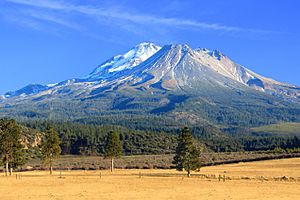
The decades following the Gold Rush brought dramatic expansion to northern California, both in population and economically – particularly in agriculture. The completion of the First Transcontinental Railroad in 1869, with its terminus in Sacramento, meant that northern California's agricultural produce (and some manufactured goods) could now be shipped economically to the rest of the United States. In return, immigrants from the rest of the United States (and Europe) could comfortably come to northern California. A network of railroads spread throughout northern California, and in 1887, a rail link was completed to the Pacific Northwest. Almost all of these railways came under the control of the Southern Pacific Railroad, headquartered in San Francisco, and San Francisco continued as a financial and cultural center.
Substantial tensions during this era included nativist sentiments (primarily against Chinese immigrants), tensions between the increasing power of the Southern Pacific Railroad and small farmers, and the beginnings of the labor union movement.
Climate
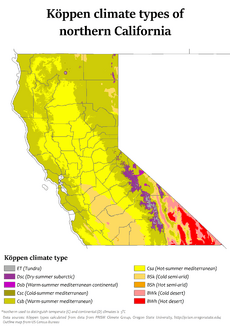
Northern California has warm or mild to cold climate, in which the Sierra gets snow in the late fall through winter and occasionally into spring. Summers are warm and dry while winters are cool and usually wet. The high temperatures range from 50's to 30's in the winters while as summers temperatures range is 90's to 60's or 50's, with highs well into the 100s for the Sacramento region. Snow gets covered on the mountains in mid January through February. Fog occurs infrequently or occurs normally in the west and coast.
Population
| Historical population | |||
|---|---|---|---|
| Census | Pop. | %± | |
| 1850 | 86,105 | — | |
| 1860 | 346,714 | 302.7% | |
| 1870 | 516,089 | 48.9% | |
| 1880 | 772,778 | 49.7% | |
| 1890 | 961,628 | 24.4% | |
| 1900 | 1,147,725 | 19.4% | |
| 1910 | 1,569,141 | 36.7% | |
| 1920 | 2,003,075 | 27.7% | |
| 1930 | 2,632,273 | 31.4% | |
| 1940 | 3,066,654 | 16.5% | |
| 1950 | 4,654,248 | 51.8% | |
| 1960 | 6,318,482 | 35.8% | |
| 1970 | 7,849,575 | 24.2% | |
| 1980 | 9,359,160 | 19.2% | |
| 1990 | 11,490,926 | 22.8% | |
| 2000 | 13,234,136 | 15.2% | |
| 2010 | 14,573,946 | 10.1% | |
The population of the forty-eight counties of northern California has shown a steady increase over the years. The 1850 census almost certainly undercounted the population of the area, especially undercounting a still substantial Native American population.
The largest percentage increase outside the Gold Rush era (51%) came in the decade of the 1940s, as the area was the destination of many post-War veterans and their families, attracted by the greatly expanding industrial base and (often) by their time stationed in northern California during World War II. The largest absolute increase occurred during the decade of the 1980s (over 2.1 million person increase), attracted to job opportunities in part by the expansion taking place in Silicon Valley and the Cold War era expansion of the defense industry. The 2010 U.S. Census revealed that northern California grew at a faster rate than Southern California in the 2000s with a rate slightly higher than the state average.
Parks and other protected areas
National Park System
The U.S. National Park System controls a large and diverse group of parks in northern California. The best known is Yosemite National Park, which is displayed on the reverse side of the California state quarter. Other prominent parks are the Kings Canyon-Sequoia National Park complex, Redwood National Park, Pinnacles National Park, Lassen Volcanic National Park and the largest in the contiguous forty-eight states, Death Valley National Park.
National Monuments and other federally protected areas
Other areas under federal protection include Muir Woods National Monument, Giant Sequoia National Monument, Devils Postpile National Monument, Lava Beds National Monument, Point Reyes National Seashore, the Monterey Bay National Marine Sanctuary, and the Cordell Bank and Gulf of the Farallones National Marine Sanctuaries (both off the coast of San Francisco). Included within the latter National Marine Sanctuary is the Farallon National Wildlife Refuge; this National Wildlife Refuge is one of approximately twenty-five such refuges in northern California. National forests occupy large sections of northern California, including the Shasta-Trinity, Klamath, Modoc, Lassen, Mendocino, Eldorado, Tahoe, and Sequoia national forests, among others. Included within (or adjacent to) national forests are federally protected wilderness areas, including the Trinity Alps, Castle Crags, Granite Chief, and Desolation wilderness areas.
In addition, the California Coastal National Monument protects all islets, reefs, and rock outcroppings from the shore of northern California out to a distance of 12 nautical miles (22.22 km), along the entire northern California coastline. In addition, the National Park Service administers protected areas on Alcatraz Island, the Golden Gate National Recreation Area, and the Whiskeytown National Recreation Area. The NPS also administers the Manzanar National Historic Site in Inyo County, the Rosie the Riveter/World War II Home Front National Historical Park in Richmond, and the Tule Lake Unit of the World War II Valor in the Pacific National Monument outside of Tulelake.
Other parks and protected areas
- Marble Mountain Wilderness
- Mount Tamalpais State Park
- Suisun Marsh
- Sacramento River
- Turtle Bay Exploration Park
- McArthur-Burney Falls Memorial State Park
- Wilder Ranch State Park
- Sequoia National Park
Counties
Regions
The following regions are entirely or partly within northern California:
- Big Sur
- Cascade Range
- Central California
- Central Coast
- Central Valley
- Coastal California
- East Bay (SF)
- Eastern California
- Emerald Triangle
- Gold Country
- Greater Sacramento
- Klamath Basin
- Lake Tahoe
- Lassen Peak
- Lost Coast
- Metropolitan Fresno
- Mount Shasta
- North Bay (SF)
- North Coast
- Russian River
- Sacramento Valley
- San Francisco Bay Area
- San Francisco Peninsula
- San Joaquin Valley
- Santa Clara Valley
- Shasta Cascade
- Sierra Nevada
- Silicon Valley
- South Bay (SF)
- Telecom Valley
- Tri-Valley
- Trinity Alps
- Wine Country
- Yosemite
- Yuba-Sutter Area
Cities and towns in northern California with more than 50,000 inhabitants
|
| City | Population (2010) |
|---|---|
| Alameda | 73,812 |
| Antioch | 102,372 |
| Berkeley | 112,580 |
| Brentwood | 51,481 |
| Chico | 86,187 |
| Citrus Heights | 83,301 |
| Clovis | 95,631 |
| Concord | 122,067 |
| Cupertino | 58,302 |
| Daly City | 101,123 |
| Davis | 65,622 |
| Elk Grove | 153,015 |
| Fairfield | 105,321 |
| Folsom | 72,203 |
| Fresno | 510,365 |
| Fremont | 214,089 |
| Hanford | 53,967 |
| Hayward | 144,186 |
| Livermore | 80,968 |
| Lodi | 62,134 |
| Madera | 61,416 |
| Manteca | 67,096 |
| Merced | 78,958 |
| Milpitas | 66,790 |
| Modesto | 201,165 |
| Mountain View | 74,066 |
| Napa | 76,915 |
| Novato | 51,904 |
| Oakland | 390,724 |
| Palo Alto | 64,403 |
| Petaluma | 57,941 |
| Pittsburg | 63,264 |
| Pleasanton | 70,285 |
| Porterville | 54,165 |
| Rancho Cordova | 64,776 |
| Redding | 89,861 |
| Redwood City | 76,815 |
| Richmond | 103,701 |
| Rocklin | 56,974 |
| Roseville | 118,788 |
| Sacramento | 466,488 |
| Salinas | 150,441 |
| San Francisco | 805,235 |
| San Jose | 945,942 |
| San Leandro | 84,950 |
| San Mateo | 97,207 |
| San Rafael | 57,713 |
| San Ramon | 72,148 |
| Santa Clara | 116,468 |
| Santa Cruz | 59,946 |
| Santa Rosa | 167,815 |
| South San Francisco | 63,632 |
| Stockton | 291,707 |
| Sunnyvale | 140,081 |
| Tracy | 82,922 |
| Tulare | 59,278 |
| Turlock | 68,549 |
| Union City | 69,516 |
| Vacaville | 92,428 |
| Vallejo | 115,942 |
| Visalia | 124,442 |
| Walnut Creek | 64,173 |
| Watsonville | 51,199 |
| Woodland | 55,468 |
| Yuba City | 64,925 |
Metropolitan areas
Northern California is home to three of the state's four extended metropolitan areas that are home to over three-fourths of the region's population as of the 2010 United States Census:
| Metropolitan region | Population |
|---|---|
| San Francisco Bay Area | 7,468,390 |
| Greater Sacramento | 2,461,780 |
| Metropolitan Fresno | 1,081,315 |
Major business districts
The following are major central business districts:
- San Francisco Financial District
- Downtown Oakland
- Downtown Sacramento
- Downtown San Jose
Transportation
See also articles:
- Transportation in the Sacramento metropolitan area
- Transportation in the San Francisco Bay Area
See also categories:
- Transportation in Alameda County
- Transportation in Alpine County
- Transportation in Amador County
- Transportation in Butte County
- Transportation in Calaveras County
- Transportation in Colusa County
- Transportation in Contra Costa County
- Transportation in Del Norte County
- Transportation in El Dorado County
- Transportation in Fresno County
- Transportation in Glenn County
- Transportation in Humboldt County
- Transportation in Inyo County
- Transportation in Kings County
- Transportation in Lake County
- Transportation in Lassen County
- Transportation in Madera County
- Transportation in Marin County
- Transportation in Mariposa County
- Transportation in Mendocino County
- Transportation in Merced County
- Transportation in Modoc County
- Transportation in Mono County
- Transportation in Monterey County
- Transportation in Napa County
- Transportation in Nevada County
- Transportation in Oakland
- Transportation in Placer County
- Transportation in Plumas County
- Transportation in Sacramento
- Transportation in Sacramento County
- Transportation in San Benito County
- Transportation in the San Francisco Bay Area
- Transportation in San Francisco
- Transportation in San Joaquin County
- Transportation in San Mateo County
- Transportation in Santa Clara County
- Transportation in Santa Cruz County
- Transportation in Shasta County
- Transportation in Sierra County
- Transportation in Siskiyou County
- Transportation in Solano County
- Transportation in Sonoma County
- Transportation in Stanislaus County
- Transportation in Sutter County
- Transportation in Tehama County
- Transportation in Trinity County
- Transportation in Tulare County
- Transportation in Tuolumne County
- Transportation in Yolo County
- Transportation in Yuba County
Airports
There are 11 airports in Northern California categorized as Primary Service Commercial airports by the FAA:
| Airport | ID | City | Category | 2018 Enplanements |
|---|---|---|---|---|
| San Francisco International Airport | SFO | San Francisco | Large Hub | 27,794,154 |
| San Jose International Airport | SJC | San Jose | Medium Hub | 7,037,144 |
| Oakland International Airport | OAK | Oakland | Medium Hub | 6,687,963 |
| Sacramento International Airport | SMF | Sacramento | Medium Hub | 5,907,901 |
| Fresno Yosemite International Airport | FAT | Fresno | Small Hub | 853,538 |
| Charles M. Schulz–Sonoma County Airport | STS | Santa Rosa | Non Hub | 217,994 |
| Monterey Regional Airport | MRY | Monterey | Non Hub | 188,046 |
| Stockton Metropolitan Airport | SCK | Stockton | Non Hub | 99,258 |
| Arcata-Eureka Airport | ACV | Arcata | Non Hub | 69,604 |
| Redding Municipal Airport | RDD | Redding | Non Hub | 42,775 |
| Mammoth Yosemite Airport | MMH | Mammoth Lakes | Non Hub | 23,522 |
Railroad
- Bay Area Rapid Transit (BART) – commuter subway connecting most of the core Bay Area including San Francisco, Oakland, and San Jose
- Caltrain – commuter rail between San Francisco and Gilroy (south of San Jose)
- Muni Metro (San Francisco)
- VTA Light Rail (San Jose)
- Altamont Commuter Express (ACE) – commuter train connecting Stockton and the Central Valley with San Jose and the Bay Area
- Sacramento Regional Transit District light rail
- Amtrak:
- California Zephyr – connects Chicago to the Bay Area
- Capitol Corridor – San Jose to Auburn (eastern suburb of Sacramento)
- Coast Starlight – coastal train between Los Angeles and Seattle with northern California stops in San Jose, Oakland, and Sacramento
- San Joaquin – Central Valley train linking Bakersfield in the Central Valley to Sacramento and Oakland
Major transit organizations
- AC Transit
- Arcata and Mad River Transit System
- County Connection
- El Dorado Transit
- Eureka Transit Service
- Fairfield and Suisun Transit
- Fresno Area Express
- Golden Gate Transit
- Lake Transit
- Mendocino Transit Authority
- Monterey-Salinas Transit
- Porterville City Operated Local Transit
- Redwood Transit System
- SamTrans
- San Benito Express
- SF MUNI
- San Joaquin Regional Transit District
- Santa Clara Valley Transportation Authority (VTA)
- Santa Cruz Metro
- Solano Express
- SolTrans
- Sonoma County Transit
- Tri Delta Transit
- Visalia Transit
- VINE (Napa County)
Major transit ferries
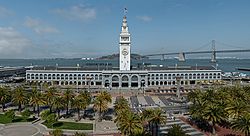
- San Francisco Bay Ferry
- Golden Gate Ferry
- Blue & Gold Fleet
- Angel Island - Tiburon Ferry
Freeways
Interstate highways
 Interstate 80 (Eastshore Freeway/Lincoln Highway)
Interstate 80 (Eastshore Freeway/Lincoln Highway) Interstate 280 (Southern Embarcadero Freeway/Southern Freeway/Junipero Serra Freeway/Sinclair Freeway)
Interstate 280 (Southern Embarcadero Freeway/Southern Freeway/Junipero Serra Freeway/Sinclair Freeway) Interstate 380
Interstate 380 Interstate 580 (Eastshore Freeway/MacArthur Freeway/Brown Freeway)
Interstate 580 (Eastshore Freeway/MacArthur Freeway/Brown Freeway) Interstate 680 (Joseph P. Sinclair Freeway/Donald D. Doyle Highway/Blue Star Memorial Highway/Luther E. Gibson Freeway)
Interstate 680 (Joseph P. Sinclair Freeway/Donald D. Doyle Highway/Blue Star Memorial Highway/Luther E. Gibson Freeway) Interstate 780
Interstate 780 Interstate 880 (Nimitz Freeway)
Interstate 880 (Nimitz Freeway) Interstate 980 (Grove-Shafter Freeway)
Interstate 980 (Grove-Shafter Freeway) Interstate 238
Interstate 238 Interstate 5 (Golden State Freeway/West Side Freeway)
Interstate 5 (Golden State Freeway/West Side Freeway) Interstate 205 (Robert T. Monagan Freeway)
Interstate 205 (Robert T. Monagan Freeway) Interstate 505
Interstate 505 Interstate 80 Business (Capital City Freeway)
Interstate 80 Business (Capital City Freeway)
U.S. Routes
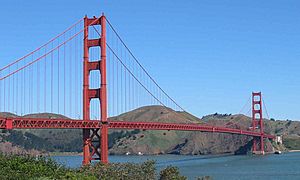
 U.S. Route 6
U.S. Route 6 U.S. Route 50 (El Dorado Freeway)
U.S. Route 50 (El Dorado Freeway) U.S. Route 101 (South Valley Freeway/Bayshore Freeway/James Lick Freeway/Central Freeway/Redwood Highway/Michael J. Burns Freeway/Redwood Highway)
U.S. Route 101 (South Valley Freeway/Bayshore Freeway/James Lick Freeway/Central Freeway/Redwood Highway/Michael J. Burns Freeway/Redwood Highway) U.S. Route 395
U.S. Route 395 U.S. Route 97
U.S. Route 97 U.S. Route 199
U.S. Route 199
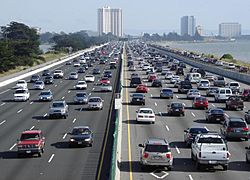
Principal state highways
 State Route 1 (Pacific Coast Highway/Cabrillo Highway)
State Route 1 (Pacific Coast Highway/Cabrillo Highway) State Route 3
State Route 3 State Route 4
State Route 4 State Route 9
State Route 9 State Route 12
State Route 12 State Route 13 (Ashby Avenue/Tunnel Road/Warren Freeway)
State Route 13 (Ashby Avenue/Tunnel Road/Warren Freeway) State Route 16
State Route 16 State Route 17
State Route 17 State Route 20
State Route 20 State Route 24
State Route 24 State Route 25
State Route 25 State Route 26
State Route 26 State Route 29
State Route 29 State Route 32
State Route 32 State Route 33
State Route 33 State Route 35 (Skyline Boulevard)
State Route 35 (Skyline Boulevard) State Route 36
State Route 36 State Route 37 (Sears Point Tollway)
State Route 37 (Sears Point Tollway) State Route 41 (E.G. Lewis Highway, Yosemite Freeway, Southern Yosemite Highway, Wawona Road)
State Route 41 (E.G. Lewis Highway, Yosemite Freeway, Southern Yosemite Highway, Wawona Road) State Route 43
State Route 43 State Route 44
State Route 44 State Route 49 (Golden Chain Highway)
State Route 49 (Golden Chain Highway) State Route 59
State Route 59 /
/ /
/ State Route 61 (Webster Tube/Posey Tube/Doolittle Drive/Davis Street)
State Route 61 (Webster Tube/Posey Tube/Doolittle Drive/Davis Street) State Route 63
State Route 63 State Route 65
State Route 65 State Route 68
State Route 68 State Route 70
State Route 70 State Route 82 (Monterey Highway/El Camino Real/Mission Street)
State Route 82 (Monterey Highway/El Camino Real/Mission Street) State Route 84
State Route 84 State Route 85 (Stevens Creek Freeway/West Valley Freeway/Norman Y. Mineta Highway/CHP Officer Scott M. Greenly Memorial Freeway)
State Route 85 (Stevens Creek Freeway/West Valley Freeway/Norman Y. Mineta Highway/CHP Officer Scott M. Greenly Memorial Freeway) State Route 87 (Guadalupe Parkway)
State Route 87 (Guadalupe Parkway) State Route 88
State Route 88 State Route 89
State Route 89 State Route 92 (J. Arthur Younger Freeway/Jackson Street)
State Route 92 (J. Arthur Younger Freeway/Jackson Street) State Route 96
State Route 96 State Route 99
State Route 99 State Route 104
State Route 104 State Route 108
State Route 108 State Route 113
State Route 113 State Route 116
State Route 116 State Route 120
State Route 120 State Route 121
State Route 121 State Route 128
State Route 128 State Route 130
State Route 130 State Route 132
State Route 132 State Route 137
State Route 137 State Route 139
State Route 139 State Route 140
State Route 140 State Route 152
State Route 152 State Route 156
State Route 156 State Route 160 (North Sacramento Freeway/River Road)
State Route 160 (North Sacramento Freeway/River Road) State Route 162
State Route 162 State Route 165
State Route 165 State Route 168
State Route 168 State Route 174
State Route 174 State Route 180
State Route 180 /
/ State Route 185 (International Boulevard/East 14th Street/Mission Boulevard)
State Route 185 (International Boulevard/East 14th Street/Mission Boulevard) State Route 190
State Route 190 State Route 193
State Route 193 State Route 198
State Route 198 State Route 201
State Route 201 State Route 216
State Route 216 State Route 219
State Route 219 State Route 236
State Route 236 State Route 237
State Route 237 State Route 238 (Mission Boulevard, Foothill Boulevard)
State Route 238 (Mission Boulevard, Foothill Boulevard) State Route 245
State Route 245 State Route 254 (Avenue of the Giants)
State Route 254 (Avenue of the Giants) State Route 262 (Mission Boulevard)
State Route 262 (Mission Boulevard) State Route 267
State Route 267 State Route 269
State Route 269 State Route 275 (Tower Bridge Gateway)
State Route 275 (Tower Bridge Gateway) State Route 299
State Route 299
Economy
Northern California's economy is noted for being the de facto world leader in high-tech industry (software, semiconductor/micro-electronics, biotechnology and medical devices/instruments), as well as being known for clean power, biomedical, government, and finance. Other significant industries include tourism, shipping, manufacturing, and agriculture. Its economy is diverse, though more concentrated in high technology, and subject to the whims of venture capital than any other major regional economy in the nation especially within Silicon Valley, and less dependent on oil and residential housing than Southern California. It is home to the state capital, as well as several Western United States regional offices in San Francisco, such as the Federal Reserve and 9th Circuit Court.
Sports
Major league professional sports teams
| Sport | League | Team | Venue | City |
|---|---|---|---|---|
| Baseball | MLB | Oakland Athletics (American League) | RingCentral Coliseum | Oakland |
| San Francisco Giants (National League) | Oracle Park | San Francisco | ||
| Basketball | NBA | Golden State Warriors | Chase Center | San Francisco |
| Sacramento Kings | Golden 1 Center | Sacramento | ||
| Football | NFL | San Francisco 49ers | Levi's Stadium | Santa Clara |
| Ice hockey | NHL | San Jose Sharks | SAP Center | San Jose |
| Soccer | MLS | San Jose Earthquakes | Avaya Stadium | San Jose |
| Indoor football | IFL | Bay Area Panthers | SAP Center | San Jose |
College sports teams
- California Golden Bears
- Stanford Cardinal
- Fresno State Bulldogs
- San Jose State Spartans
Sports venues
- Laguna Seca Raceway (motorsport)
- Sonoma Raceway (motorsport)
- Olympic Club (golf)
- Silverado Country Club (golf)
- TPC Harding Park (golf)
- TPC Stonebrae (golf)
Sporting events
- Pac-12 Football Championship Game (college football)
- Emerald Bowl (college football)
- AT&T Pebble Beach Pro-Am (golf)
- Frys.com Open (golf)
- Swinging Skirts LPGA Classic (golf)
- Grand Prix of Sonoma (motorsport)
- Toyota/Save Mart 350 (motorsport)
- Monterey Sports Car Championships (motorsport)
- Superbike World Championship (motorsport)
Educational institutions
Northern California hosts a number of world-renowned universities including Stanford University and University of California, Berkeley. Top-tier public graduate schools include Boalt Hall and Hastings law schools and UC San Francisco (a top-ranked medical school) and UC Davis School of Veterinary Medicine, the largest veterinary school in the United States.
Public
- Six University of California campuses:
-
- UC Berkeley
- UC Davis
- UC Hastings
- UC Merced
- UC San Francisco
- UC Santa Cruz
- Eleven California State University campuses:
-
- California Maritime Academy
- Chico State
- CSU East Bay
- CSU Monterey Bay
- Fresno State
- Humboldt State
- Sacramento State
- San Francisco State
- San Jose State
- Sonoma State
- Stanislaus State
- A large number of local community colleges
Private
(Partial list)
- Brandman University
- Dominican University
- Drexel University Sacramento
- Fresno Pacific University
- Holy Names University
- Mills College
- Northwestern Polytechnic University
- Pacific Union College
- Stanford University
- Santa Clara University
- St. Mary's College
- Simpson University
- Touro University California
- University of San Francisco
- University of the Pacific
- William Jessup University
- Academy of Art University
- Notre Dame de Namur University
- Samuel Merritt University
Research
(Partial list)
- American Institute of Mathematics
- Bodega Marine Reserve
- Hopkins Marine Station
- Joint Genome Institute
- Lawrence Berkeley National Laboratory
- Lawrence Livermore National Laboratory
- Lick Observatory
- Long Marine Laboratory
- Monterey Bay Aquarium Research Institute
- NASA Ames Research Center
- Owens Valley Radio Observatory
- Pacific Institute
- Point Reyes Bird Observatory
- White Mountain Research Station
Images for kids
-
Moon Lake in Lassen County, California
-
Köppen climate types in northern California
-
San Jose, the most populous city in Northern California and the San Francisco Bay Area, and the tenth largest city in the United States. San Jose is the center of Silicon Valley, the preeminent region for technology in the country.
-
San Francisco, the second most populated city in Northern California and a major economic, cultural, and financial center for the region.
-
Oakland, the fifth-largest city by population in Northern California. Oakland is the major port city of the region and the center of Northern California's African American community.
-
18 - Concord
-
36 - Manteca
-
39 - Milpitas
See also
 In Spanish: Norte de California para niños
In Spanish: Norte de California para niños


